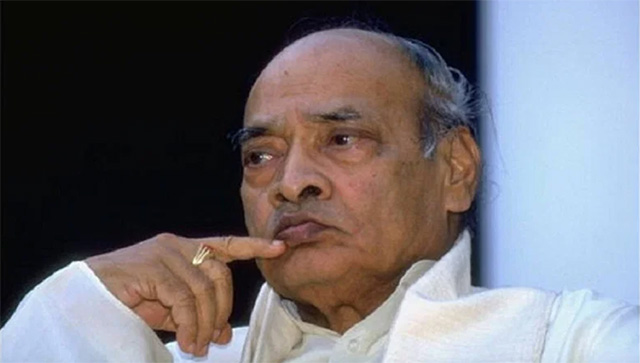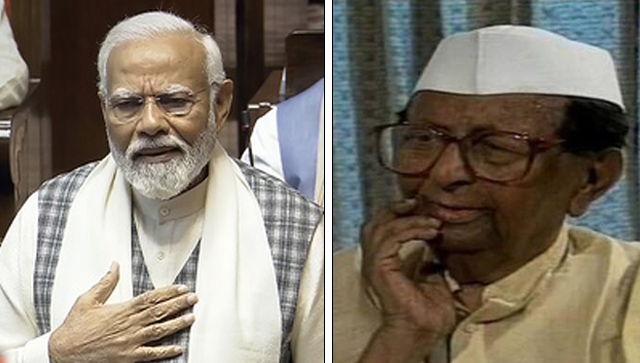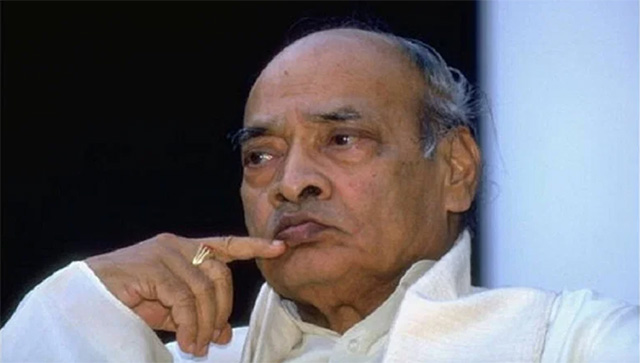“And the corrupt leaders are rightfully going to the places they deserve” – thus tweeted Nara Lokesh, son of the Andhra Pradesh Chief Minister Chandrababu Naidu and the scion of the ruling Telugu Desam Party (TDP) in the southern state, on 29 June. Along with the tweet were attached images of a press release by the Enforcement Directorate announcing attachment of properties worth Rs 749 crore belonging to political rival and leader of the opposition YSR Congress Party (YSRCP) YS Jaganmohan Reddy.
The tweet may have been short but behind it lies generations of bitter rivalry. These two families of prominent politicians, both hailing from the Rayalaseema region of Andhra Pradesh, have waged a pitched battle in full public view in the past 12 years.
The ruling TDP, whose main political rival is Reddy’s YSRCP, lashed out yet again at the Leader of the Opposition in Andhra. Describing Jagan (as Reddy is more commonly known) as an “economic terrorist” TDP spokesperson Varla Ramaiah demanded his resignation as Leader of the Opposition. “It is a dishonour to the state to have him as the Leader of Opposition as he ranked first in the list of ED attachments for criminal abetment of state funds,” he said in a statement on 29 June.
The ED has cracked down yet again on the hapless Jagan. The latest bout of attachments of land assets and stocks worth Rs 749 crore belonging to him is allegedly linked to ill-gotten money from the quid pro quo deals made by Jagan between 2004 and 2009 when his father, YS Rajasekhara Reddy was chief minister of united Andhra Pradesh.
These include Rs 344 crore worth immovable and Rs 404 crore worth movable assets. Prominent among these are Jagan’s lavish Lotus Pond bungalow in Hyderabad, his Mantri Chambers residence at Bannerghatta, Bangalore and also Sakshi Towers at Banjara Hills in Hyderabad.
This the fifth time the ED is attaching Jagan’s properties, taking the total value of properties, bank accounts, fixed deposits and stocks so far to Rs 2,524 crore. The ED attached properties in 2013, 2014 and twice in 2015 earlier.
The latest attachment though is a death blow of sorts – a direct hit at Jagan’s empire and his home. The CBI has already filed a series of chargesheets in which eight IAS officers and several industrialists who allegedly made quid pro quo payments were named.
Charges against Jagan mostly relate to money laundering, holding of disproportionate assets and quid pro quo in mining leases and land granted to companies such as Matrix, Aurobindo Pharma and Indu Projects among others. Jagan had allegedly floated 13 companies besides his Saraswati Hydel Project in Karnataka, Bharati Cements in Cuddapah in Andhra, another Hydel project in Himachal Pradesh. He is also alleged to have floated several shell companies in West Bengal, Delhi, Uttar Pradesh, Mauritius and other countries.
Jagan was arrested on 27 May, 2012 by the CBI after three days of interrogation at Hyderabad’s Dilkusha Guest House in connection with land grants given to pharma companies. He was granted bail and released from Chanchalguda jail on 24 September, 2013, seven months before the general elections. He was given a hero’s welcome with a long procession from jail to his Lotus Pond home in Jubilee Hills.
Attacking the airwaves
It was perhaps the perfect tactical move when Chief Minister of divided Andhra Pradesh, Chandrababu Naidu, decided to go after Jagan’s media empire, the Sakshi Group in early June. Naidu knew there would be no opposition or protests to his attack on Sakshi, a mouthpiece of the YSRCP and a vocal critic of the TDP government in the state.
A stir by the dominant caste group of Kapu for OBC status was initially launched in January 2016 but suspended following the burning of the Ratnanchal Express. The protests were revived again in June after Kapu leader Padmanabhan felt government had gone back on its assurances. During the January stir YSRC workers and coverage provided by Sakshi TV were blamed for the subsequent violence.
On 10 June, Telugu channel Sakshi TV went off air following a boycott by MSOs (Multiple System Operators or cable operators) for its active support of the Kapu agitation.
The channel remained off air for 13 days in all 13 districts of Andhra until Padmanabham called off his stir. “An unofficial ban was imposed. But going by the statements of Home Minister Chinna Rajappa and HRD Minister Ganta Srinivas Rao it appeared as if it was an independent action by the MSOs. Both the ministers endorsed it,” said K Sriramachandramurthy, editorial director of Sakshi Group of publications.
The unofficial clarification given by government and police was that the channel’s coverage of the Kapu agitation would have “incited people as it had done in the past.” Government sources indicated how the Sakshi coverage of Kapu Ikya Garjana (United Kapu Roar) held on 31 January at Tuni in East Godavari district had led to protestors attacking railway station and burning a Kolkata-bound Ratnanchal Express train. More than 30 miscreants were arrested in connection with that incident were labelled as YSRCP workers.
Later investigations conducted by the police into the violence at the Kapu protests in January allegedly showed that the YSRCP workers had provoked the gathered crowds. But the blot belonged to Chandrababu Naidu and his government - for mishandling the Kapu uprising and allowing it to get out of hand. “That is why the government took extraordinary precautions against such happenings during the current spate of Kapu agitation and Mudragada’s fasting,” said a senior IPS officer in the Andhra DGP’s (Director General of Police) office, justifying the state’s hand behind the unofficial blacking out of Sakshi TV.
The blatant attacks on Sakshi TV though have not evoked either sympathy or protests from the journalistic fraternity in Andhra Pradesh. In May 2012, journalists and employees working with the Sakshi Group held marches and relay hunger strikes to protest against the CBI action freezing the group’s accounts. More protests in June this year too against the channel’s black-out went largely unreported and unsupported by the rest of the press fraternity.
The silence of the media was further proof of how deep divisions run in the state, factions supporting either the TDP or the YSCRP. The Andhra Union of Journalists is said to support the government, under the guise of supporting the building of a new state and state capital. In fact, lampooning Jagan has been a fashion for the pro-TDP media and vice versa. “This indirect state control of media, though undesirable and against the spirit of democracy, is a ground reality,” said veteran editor C Raghavachari.
When asked about the alleged anti-media and anti-democratic steps against YSRCP and Sakshi, a senior bureaucrat in the Andhra Pradesh government said, on condition of anonymity, “Why talk of press freedom and all that? Have you not noticed what is happening in Tamil Nadu or under Lalu Prasad Yadav in Bihar? Has anyone raised their voice there? What happened during UPA at Delhi and now in West Bengal under Mamata Banerjee? Press freedom is not a one-way track, both have to understand and exercise their responsibilities,” he said, firmly justifying the government’s actions.
Continuing attacks
This is not the first time though that Sakshi has come under attack from the TDP government. Sakshi TV is run by Indira Television Limited, a company floated by Janani Infra, owned by Jagan. Sakshi was launched in 2009, just ahead of the Lok Sabha and state elections, quickly becoming the key mouthpiece for Jagan and his new party which was launched in March 2011.
In the wake of Jagan’s estrangement with the Congress, a half hour episode on Sonia Gandhi and the Congress high command in 2013 shook up Delhi’s political circles and thus began a systematic campaign by the Congress to cow Jagan down. The half hour episode described how Sonia Gandhi had perpetuated dynastic rule in the country and was opposing similar attempts at promotion of kith and kin within the party.
The TDP government initially filed several complaints with the Press Council of India and issued legal notices against the alleged jarring coverage and frontal attacks on Chandrababu Naidu. Advertisements from the Andhra Pradesh government for Sakshi too were slashed. Attacks by TDP men on Sakshi offices in Guntur, Rajahmundry and Visakhapatnam for alleged wrong coverage of party activities became a regular feature. Several times, power lines were shut down to disable broadcasts of the channel and printing of Sakshi newspapers.
As the ED went about attaching Jagan’s properties, the Andhra government appeared keen to take over his land assets under a newly made law – the Andhra Pradesh Special Courts Bill 2015 , passed by the House in September 2015, which is awaiting the President’s assent. (Link: http://www.thehindu.com/news/cities/Hyderabad/ap-assembly-passes-special-courts-bill/article7614699.ece)
Once the Bill is notified, the government plans to set up special courts to fast-track and ensure time-bound trial of illegal wealth cases. The Act will also give powers to the state government to “acquire disproportionate assets” for the common good. “The process will be just like acquiring private land for parks,SEZs and road widening exercises,” explained a senior Revenue Department official. The TDP’s immediate intent was clear. At the height of the Kapu agitation in January 2016, Finance Minister Yanamala Ramakrishnudu declared in a television interview that there was nothing wrong if the state took control of Jagan’s media house as this too was born out of money looted from the state.
“The vulnerability and dependence of the print and visual media on advertisement money from the government sources had led many big and medium media houses to toe the government and ruling party line. Both Chandrababu and K Chandrasekhar Rao exploited that weak spot,” said a senior Hyderabad-based journalist who did not wish to be named.
“In my 30 years of journalism, this is the worst kind of intimidation on media and persistently made by those in authority, violating all norms of press freedom. Problem is intolerance towards criticism from all quarters,” said Devulapalli Amar, a veteran news anchor and columnist of Hyderabad who is now employed with Sakshi.
An uneven battle
The war is on between the two political leaders. But Naidu has always had the upper hand in this battle, simply by dint of of his muscle power and experience in handling ‘detractors’ in his three-decade political life.
The might of the Telugu Desam Party has repeatedly launched no-holds-barred attacks on Jagan, especially inside the state Assembly. Jagan would barely be allowed to make his point, and his frequent memorandums to Governor and to the Centre would yield no results. Jagan was always booed and heckled in the Assembly by TDP ministers and legislators. State Labour Minister Acham Naidu called Jagan a criminal offender who should be in jail. “If all the ill-gotten money of Jagan, of around Rs 1.2 lakh crore is attached to government we could build a new capital without any debts,” he said in Assembly in March 2016.
Jagan had few defenders in the Assembly. His own party men who stood up to speak on his behalf simply did not have the lung power to match the pressure from the treasury benches. In the last two years, 52 YSRCP MLAs were routinely suspended, out of the total strength of 67, for questioning ministers and raising issues unsavoury to the party in power. Nagari segment MLA Rojawas suspended for one year in December 2015 for making ‘derogatory comments’ against the Chief Minister, a move upheld by the Andhra Pradesh High Court .
The TDP is also heaping the pressure on YSRCP, enticing their legislators to jump ship. “In just a few months from now Jagan may have to go back to jail as the CBI trial is likely to reach closure soon,” senior TDP spokesperson Somireddy Chandramohan Reddy told Firspost. Over 10 MLAS and two MPs from YSRCP have made a beeline to TDP since 2014.
“We chose TDP as an alternative to the whimsical and autocratic style of Jagan,” said Allagadda MLA Bhuma Nagi Reddy who joined the TDP recently. “He lacks the political acumen and body language of his father,” he said, on the sidelines of the event held on his joining the TDP in February this year.
An old rivalry
For reasons best known only to them, once close friends — YS Rajasekhar Reddy and Chandrababu Naidu — both peers in the Congress party in the 1970s, decided to part ways. These two powerful politicians hailing from the Rayalaseema region — Naidu from Nellore and YSR from Cuddapah — once shared the same room in the Congress office. Since 1974, though their political paths split and the bitterness was out in the open.
Naidu hitched his star to that of his father-in-law and charismatic actor NT Rama Rao as the Congress’ decline in united Andhra Pradesh began in the 1980s. YSR remained loyal to the ‘hand’, serving as MP and MLA for several terms until 2004, when he became the Chief Minister of the state.
Naidu is an adept political hand – he has ruthlessly put down dissidents within the party, even overthrowing his own father-in-law NTR to take control of the party in the 1990s. YSR died prematurely in 2009, as Chief Minister, in a tragic chopper crash in the Nallamalla forests. Jagan, a political greenhorn, riding on his late father’s popularity, was simply no match for the wily Naidu.
Many in Congress and TDP circles point out that Naidu was paying back YSRCP and Jagan in the same coin as to how YSR treated him for five years when Naidu was the Leader of the Opposition. YSR’s government did not allot new vehicles to Naidu at the time, despite his convoy of old Ambassador cars breaking down routinely on the roads. Naidu has Z-Plus category security as there is a perceived high risk threat to his life. When Naidu, tired of dealing with breakdowns, wanted to buy his own SUV, it was rejected, citing security reasons. It was only after the death of YSR that the new Chief Minister K Rosaiah allotted Naidu new vehicles.
As Chief Minister between 1995-2004, Naidu had cancelled a mining lease for baryites (a mineral from which barium is extracted) of the YSR family in Cuddapah district and also refused land approvals for a housing plot in Banjara Hills. When YSR became Chief Minister in 2004, apart from not sanctioning new vehicles and security to Naidu, he also initiated several commissions of enquiry against his main political rival.
This rivalry has now trickled down the generations. Chandrababu Naidu’s son Nara Lokesh is often derisively referred to as “Amul Baby” by the YSRCP, while TDP spokespersons taunt Jagan, calling him “Moddabbai” (dumb kid).
Jagan’s sudden catapult into the limelight in 2009, following the death of his father, came as an uneasy development for Naidu, who was preparing for his son Lokesh’s entry into politics and party work. A sympathy wave for Jagan in the wake of his father’s death, accompanied with the popularity of YSR’s welfare schemes such as the Indiramma housing scheme, tuition fee reimbursements and free power to farmers, set Naidu on the backfoot.
“The TDP-BJP alliance turned out to be a win-win combination during 2014 polls in the backdrop of Jagan’s involvement in the quid pro quo case and his credibility as a political leader,” said Nageshwar, currently chief editor of Hans India.
Analysts say that Naidu’s marathon padayatra, his promise to waive the entire farmers’ loan arrears, support of the Dalits and the total eclipse of the Congress worked against Jagan in spite of strong media publicity.
Even Jagan’s own party men whisper uncharitably of his political naivete. Usually dressed in striped or plain shirts in pastel colours, Jagan appeared more like a well manicured ‘spoilt son of a rich father’ than a hard bred politician from the harsh political deserts of Cuddapah, they feel. Jagan is God-fearing and a regular church-goer. His wife Bharati, daughter of a top Bangalore-based cardiologist, looks after business and welfare activities in their native Pulivendula town in Cuddapah. Jagan has two children who are in their teens.
Will Naidu manage to wipe out this powerful Rayalaseema family from the political map of Andhra Pradesh? The odds, as of now at least, are certainly stacked against Jagan.


)




)
)
)
)
)
)
)
)